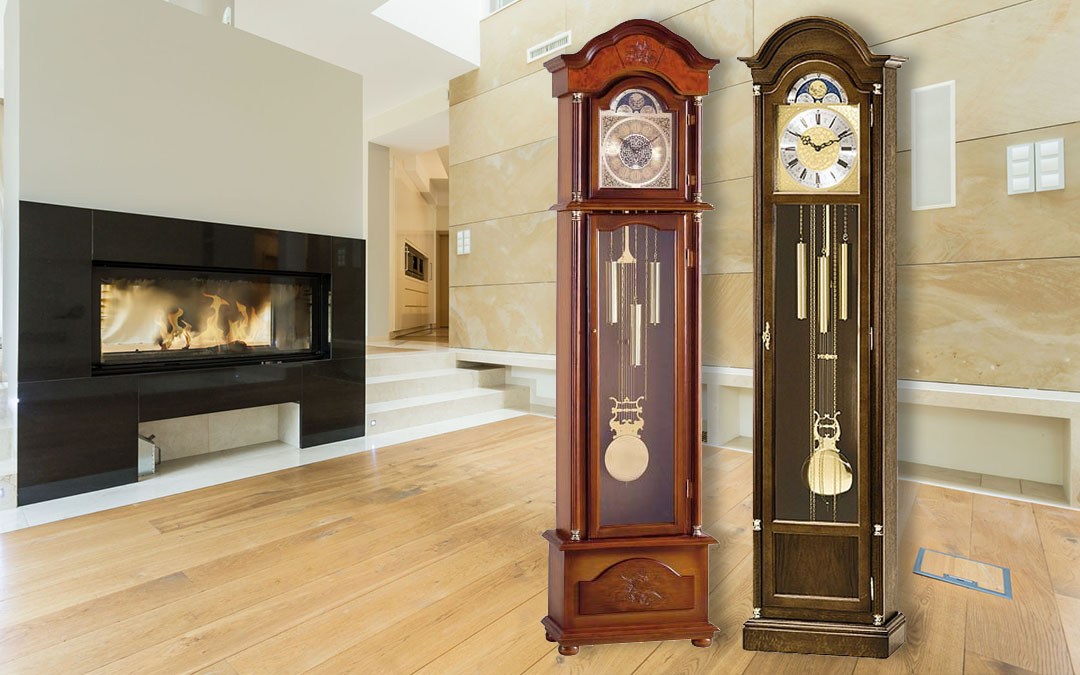1. Choosing a location
When choosing a location, you should consider the following points:
• Choose a location where the clock can be set up straight and secure.
• A place with direct sunlight or the immediate proximity of heaters / heat sources and / or drafts should be avoided.
• Please note that the volume and sound of the clock can be influenced by the size of the room, furniture, carpets, etc.
2. Unpacking and setting up the clock
• Your longcase clock is delivered in a stable shipping box.
• Carefully remove all protective papers, foils and adhesive strips.
• The clock should be set up safely and vertically (check with a water scale).
3. Mounting the pendulum and weights
• Carefully attach the pendulum to the upper part of the pendulum (hold the upper part with one hand and hang the pendulum with the other).
• The pendulum should hang straight when it is not in motion. If it is not vertical, check whether the housing is even with the ground.
• The correct position inside the clock is marked on the underside of each weight.
• Now attach the weights to the cable guide or rather the eyelets or hooks at the ends of the chain as indicated on the undersides of the weights.
• Then move the pendulum sideways to the casing wall and let it swing. The initially large pendulum motions will decrease – it will oscillate evenly.
4. Setting the time
• Set the correct time by slowly moving the minute hand counterclockwise (i.e. backwards) (about 2 hours further than the desired setting).
• When you move the minute hand counterclockwise as described, the striking mechanism will not be triggered.
• Then, move the minute hand clockwise (i.e. forward) until you reach the desired time, and let the clock strike at all trigger points (at a quarter, half, three-quarters of an hour, and at the full hour, depending on the model).
• A striking is triggered only if the minute hand is not moved over the respective trigger point too fast.
• Avoid touching the hour hand to make sure it does not move.
• The clock will automatically adjust itself within an hour by means of the built-in striking synchronisation and will strike according to the set melody sequence.
5. Setting the moon phase
The moon disc shows the respective phase of the moon. As long as the clock is running, the moon disc follows the moon phases automatically. If the clock stops, the moon phase must be set again. To set the moon phase:
• Turn the background disc in the upper part of the dial clockwise until the moon is just below the number 15.
• Use a calendar to determine the date of the last or next full moon. Count the number of days after the last or before the next full moon.
• Then move the moon disc forward or backward the respective days you counted. One „click“ of the moon disc corresponds to one day.
• The moon disc is now set.
6. Setting the overnight shutdown
The overnight shutdown allows an automatic skipping of the stroke (quarter or hour stroke) during the night. The overnight shutdown is at the number 9 on the dial or can be switched off with a bar below the dial. The following applies for both versions:
• Upper position: Overnight shutdown active
• Lower position: Overnight shutdown off
7. Adjusting the melody
Depending on the features, clockworks equipped with a melody stroke can play „Westminster“ (standard) and other melodies. For clocks with three melodies, you can adjust the different melodies using the stroke selection lever. Make sure that the lever snaps into place properly. It should not be between two positions and it must not be adjusted during the stroke.
8. Maintenance and care
A longcase clock needs very little maintenance and care. However, here are some steps that you can follow to preserve the functionality and look of your clock over many years:
• Wind up your clock regularly (every seven days).
• Keep the door(s) or side doors / panels closed.
• Check from time to time whether the clock is still standing straight and solid. This is particularly important during the first few months, if the clock is standing on a carpet or carpeted floor.
• Occasionally check whether the weights are still tightly screwed and properly mounted and whether the wire ropes are properly within the guides.
• It is recommended to get the clockwork lubricated by an authorized specialist every five years and have it cleaned thoroughly every ten years, depending on its location. In extreme ambient conditions (humidity and air quality, temperature, etc.), the clock may have to be lubricated and / or cleaned more often.


